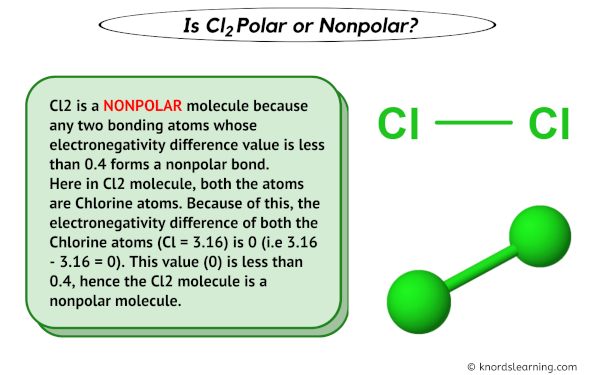
Cl2 is a NONPOLAR molecule.
But why?
And how can you say that Cl2 is a nonpolar molecule?
Want to know the reason?
Let’s dive into it!
Cl2 is a NONPOLAR molecule because any two bonding atoms whose electronegativity difference value is less than 0.4 forms a nonpolar bond.
Here in Cl2 molecule, both the atoms are Chlorine atoms. Because of this, the electronegativity difference of both the Chlorine atoms (Cl = 3.16) is 0 (i.e 3.16 – 3.16 = 0). This value (0) is less than 0.4, hence the Cl2 molecule is a nonpolar molecule.
Didn’t understand what is written above?
Let me explain this in a short and simple way (with 3D images).
You can also watch this short 2 minute video).
Why is Cl2 a Nonpolar molecule? (Explained!)
Cl2 is a nonpolar molecule because it does not have any pole of positive charge and negative charge on it. This is because both the atoms are identical (i.e both the atoms are chlorine atoms only).

But wait, let me give you some detailed information about the nonpolar nature of Cl2 molecule.
The chemical bonds can be either nonpolar, polar or ionic depending on the difference of the electronegativity values (ΔEN) between the two atoms.

Have a look at the above image.
- If the electronegativity difference (ΔEN) is less than 0.4, then the bond is nonpolar covalent bond.
- If the electronegativity difference (ΔEN) is between 0.4 to 1.7, then the bond is polar covalent bond.
- If the electronegativity difference (ΔEN) is greater than 1.7, then the bond is an ionic bond. [1] [2] [3] [4] [5]
Now let’s come to the example of Cl2 molecule.
You can see the electronegativity value of Chlorine (Cl) atom from the periodic table given below.

From the above image;
- Electronegativity of Chlorine (Cl) = 3.16 [6]
So for Cl2, the electronegativity difference (ΔEN) = 3.16 – 3.16 = 0
This value is less than 0.4, which indicates that the bond between both the Chlorine (Cl) atoms is nonpolar covalent bond.
Hence, Cl2 is a nonpolar molecule.
How Cl2 becomes a Nonpolar molecule?
In a Cl2 molecule, there are two chlorine atoms (Cl). Both these chlorine atoms are covalently bonded with each other by sharing one electron pair between them.

Here both the atoms are identical, so the electron pairs are equally attracted by both the chlorine atoms.

As the electron pairs are equally attracted towards both the chlorine atoms, there will not be any partial positive charge (ẟ+) or partial negative charge (ẟ-) on the Chlorine atoms (Cl).
And as there are no positive and negative poles of charges on the Cl2 molecule, it is a nonpolar molecule.
I hope you have understood the reason behind the nonpolar nature of Cl2 molecule.
See the polarity of other molecules to make your concepts clear:
Is HBr Polar or Nonpolar?
Is H2 Polar or Nonpolar?
Is CBr4 Polar or Nonpolar?
Is OF2 Polar or Nonpolar?
Is Ethanol (C2H5OH) Polar or Nonpolar?
Jay is an educator and has helped more than 100,000 students in their studies by providing simple and easy explanations on different science-related topics. With a desire to make learning accessible for everyone, he founded Knords Learning, an online learning platform that provides students with easily understandable explanations.
Read more about our Editorial process.
